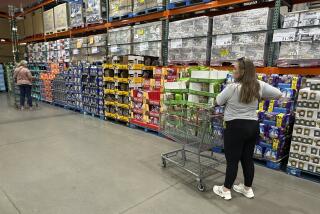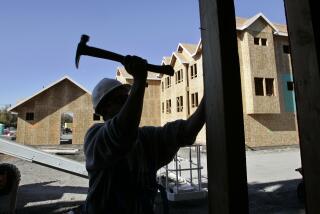Inventories Slightly Higher in July : Figures Show Economy Still Strong Despite Pause in Sales
- Share via
WASHINGTON — Business inventories in July rose at the slowest rate in 11 months, the government said Friday, suggesting to analysts that underlying economic growth remains strong despite a pause in business sales.
The Commerce Department said inventories rose 0.3% to a seasonally adjusted $733.7 billion. It was the 19th consecutive gain, but the smallest since a 0.2% increase in August, 1987.
Economists sometimes take rising inventories as a sign of weakness, fearing that too many goods piling up on shelves and back lots will trigger production cutbacks and layoffs at factories.
However, they point out that the buildup over the last year and a half has been accompanied by strong sales, despite a dip in July.
“The key thing to me is that inventories are remaining very moderate, so basically the implication is for strong third- and fourth-quarter growth,” said Robert Wescott, chief economist of Alphametrics, a consulting firm in Bala Cynwyd, Pa.
Business sales fell 0.2% in July to $487.7 billion, the first decline since November when some buyers were spooked by the October stock market crash.
However, the slight drop followed a very strong 1.4% jump in June, the second best in more than a year.
“When you put June and July together, sales are still growing strongly,” said James Annable, chief economist of First National Bank of Chicago. “The fundamental message that comes out of it is we’re not in a period of excessive inventory buildup. If the economy does slow, it’s not going to be in order to work down inventories.”
The combination of weak sales and slowly rising inventories left the inventory-to-sales ratio at 1.50, unchanged from June and from a year ago. That means it would take 1.50 months to exhaust inventories at the July sales pace, a ratio not considered abnormally high.
Kathleen Cooper, chief economist of Security Pacific National Bank in Los Angeles, said the ratio has jumped up to the 1.75 range before recessions in the 1970s and 1980s.
The July inventory accumulation was led by 0.5% increases at both the manufacturing and wholesale levels. Inventories shrank by 0.1% at the retail level, where sales have been weakest in recent months.
In sales, a 0.9% decline at factories more than offset a 0.6% rise at the wholesale level and a slight 0.1% increase at retail stores.
An advance estimate of retail sales for August, released Thursday, showed a 0.2% decrease.
More to Read
Inside the business of entertainment
The Wide Shot brings you news, analysis and insights on everything from streaming wars to production — and what it all means for the future.
You may occasionally receive promotional content from the Los Angeles Times.










